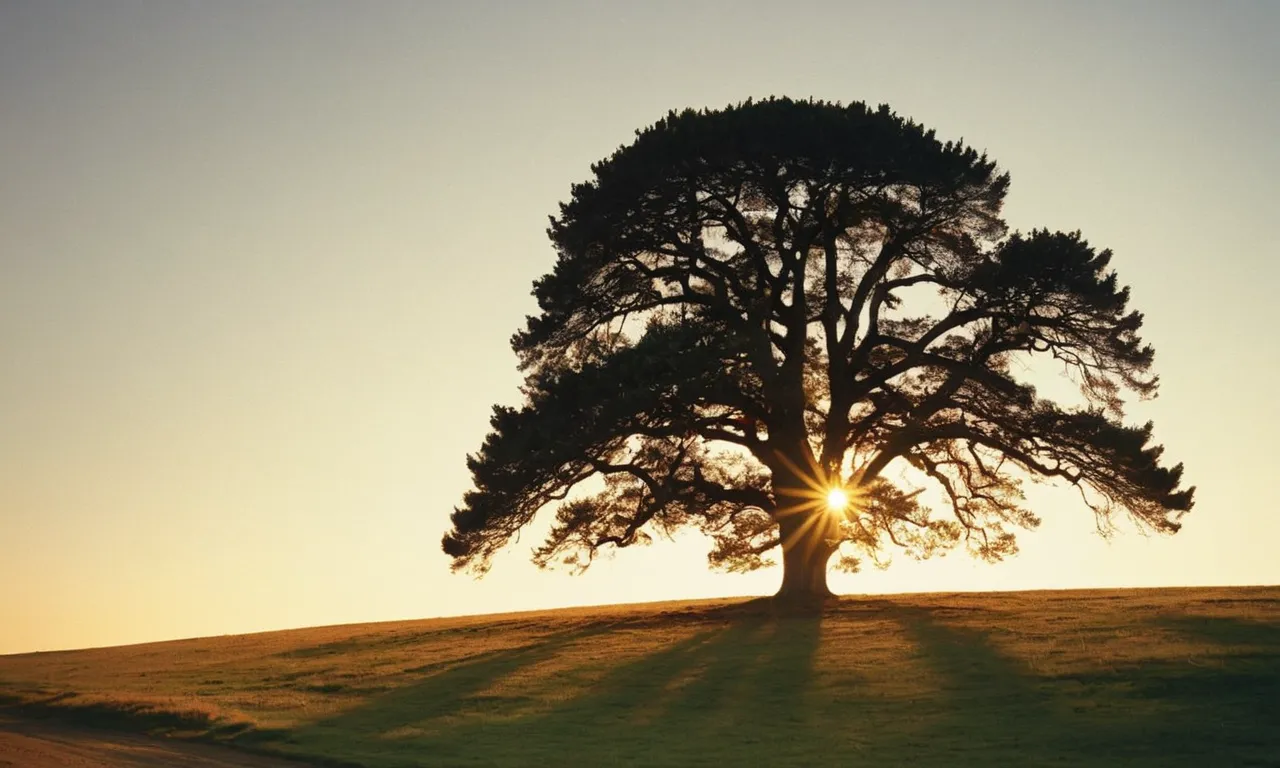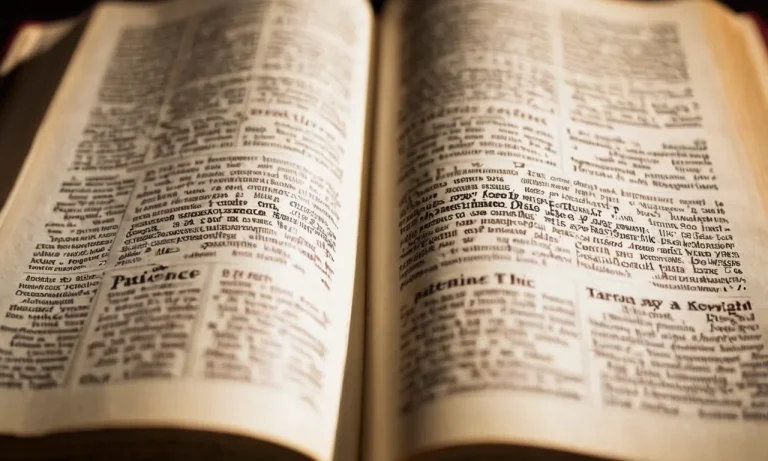What Do Trees Represent In The Bible?
Trees are mentioned hundreds of times throughout the Bible, often used symbolically or metaphorically. If you’re short on time, here’s a quick answer: Trees in the Bible generally represent life, growth, fruitfulness, and the blessings of God.
In this nearly 3000 word article, we will explore the varied symbolic meanings behind trees in both the Old and New Testaments. We’ll look at specific types of trees like the cedar, palm, fig, olive, and more.
And we’ll see how trees and plants represent themes of flourishing, righteousness, the peace of Messianic age, the wisdom of God, and the salvation offered through Jesus Christ.
Trees as Symbols of Life and Blessing
The Cedar Tree
The cedar tree is mentioned over 70 times in the Bible and is a symbol of blessing, protection and prosperity. Cedars grow very tall and wide, providing shade and shelter, which is why the Bible refers to the “cedars of Lebanon” when describing God’s blessings for the faithful (Psalms 92:12).
King Solomon used cedar wood to build the Temple in Jerusalem, showing its holy status (1 Kings 6). Cedar oil was also used for purification rituals, and cedar wood for idol poles, both demonstrating its sacred nature.
The Palm Tree
Palm trees symbolize peace, victory and eternal life in the Bible. Palm branches were waved to celebrate Jesus’ triumphal entry into Jerusalem (John 12:13). The palm was also carved into the walls and doors of Solomon’s temple (1 Kings 6:29).
Palms grow straight up toward heaven, representing victory and resurrection. Revelation 7:9 describes a multitude from every nation waving palm branches and crying “Salvation belongs to our God.” Palms thus represent the righteous rejoicing in God’s salvation.
The Fig Tree
The fig tree often represents the health, prosperity and peace of Israel in the Bible. Old Testament prophets promised that faithfulness to God would lead to abundant harvests of figs and other fruits (Jeremiah 8:13, Hosea 9:10).
Jesus cursed a fig tree for not bearing fruit, symbolizing Israel’s spiritual barrenness (Matthew 21:18-21). The fig tree is also used to portray the end times, when the budding of the fig tree signals that “summer is near” and Christ’s return is coming (Matthew 24:32).
The Olive Tree
The olive tree symbolizes fruitfulness, beauty, dignity and peace in the Bible. Olive trees live and bear fruit for centuries, depicting a long, flourishing life. Olive oil was used to anoint kings and priests, appointing them for holy service.
The olive branch remains a universal symbol of peace today. Romans 11 describes Gentiles as a “wild olive shoot” grafted into the cultivated olive tree of Israel, picturing how non-Jews join God’s chosen people through faith in Jesus.
Trees Representing Israel and Spiritual Truths
The Vine as God’s People
In the Bible, the vine is often used as a symbol for Israel or God’s people. One example is in Psalm 80:8 which says, “You transplanted a vine from Egypt; you drove out the nations and planted it.” This refers to God bringing Israel out of Egypt and establishing them in the Promised Land.
Jesus also refers to Himself as the “true vine” and God as the gardener in John 15, indicating He is the ultimate fulfillment of Israel.
Another key passage is Isaiah 5:1-7 which tells the parable of God planting a vineyard (Israel), caring for it, and expecting good fruit, but instead getting bitter fruit. This symbolized Israel’s spiritual failures and rebellion against God.
Overall, the vine epitomizes Israel’s special relationship with God, though it needed pruning and refinement to properly represent God’s purposes.
The Branch as the Messiah
The branch is used prophetically in several Old Testament passages to represent the coming Messiah. For example, Jeremiah 23:5 speaks of a “righteous Branch” who will come from David’s line and reign as king, bringing justice.
Similarly, Zechariah 3:8 refers to the Messiah as God’s “servant, the Branch” who will remove iniquity in a single day.
Perhaps most significantly, Isaiah 11:1 predicts, “A shoot will come up from the stump of Jesse; from his roots a Branch will bear fruit.” Jesse was King David’s father, so this Branch represents a new sprout from David’s family tree who will redeem Israel.
The New Testament confirms Jesus as this prophesied Messiah from the line of David (Rom 1:3). Just as new branches grow from old stumps, Jesus grew out of Israel’s stump and fulfilled the prophecies as the Branch.
The Tree of Life
The tree of life, first mentioned in Genesis 2:9 in the Garden of Eden, represents God’s provision for immortality. The tree imparts life to those who eat from it (Gen 3:22). In Revelation 22:2, the tree of life reappears in the New Jerusalem, yielding fruit each month.
Those who wash their robes have the right to eat from it and receive everlasting life and healing.
Thus, the tree of life represents the eternal life offered by Christ. By partaking of Jesus spiritually, believers gain immortality. Though banned from Eden’s tree after the fall, finally in the New Jerusalem, God’s people can freely eat of the tree of life and live forever in God’s presence.
Jesus Christ as the True Tree of Life
In the Bible, trees often symbolize life, growth, strength, and protection. One of the most significant tree symbols is the Tree of Life, first mentioned in Genesis. This tree represents immortality, eternal life, blessings, and spiritual nourishment.
Jesus Christ is portrayed as the ultimate fulfillment of the Tree of Life symbol. Through His sacrificial death on the cross and glorious resurrection, Jesus offers the gift of eternal life to all who put their faith in Him (John 3:16). Here are some key ways Jesus embodies the Tree of Life:
He is the source of spiritual nourishment and blessings
Jesus declared, “I am the bread of life” (John 6:35). Just as bread sustains physical life, Jesus sustains us spiritually as we feed on His Word and draw close to Him. Hesatisfies our deepest needs and provides blessings beyond measure.
As the True Tree of Life, Jesus invites us to find fulfillment in relationship with Him.
He conquered death and offers eternal life
Unlike the original Tree of Life which Adam and Eve were barred from after the Fall, Jesus now grants access to the tree that leads to immortality. By rising from the dead, He defeated sin and death and opened the door for us to have everlasting life with God (1 Corinthians 15:54-57).
All who entrust their lives to Him can freely eat from the Tree of Life (Revelation 2:7).
He restores our relationship with God
Sin severed humanity’s intimate connection with God. But Jesus, the True Tree of Life, bridges that gap. He is the mediator through whom we can be reconciled and enjoy closeness with the Father again (1 Timothy 2:5-6).
By faith in Christ, we go from estranged to beloved children who can freely commune with God.
Jesus is the life source who invites all who hunger for purpose, meaning, and eternal blessing to find satisfaction in Him alone. Those who partake of Christ, the True Tree of Life, will discover the joys of intimacy with God that last for eternity.
Conclusion
As we have seen, trees have deep symbolic meaning all throughout Scripture. They represent life, growth, fruitfulness, wisdom, righteousness, and peace. Specific trees like the cedar, palm, fig, olive, vine, and branch point to spiritual realities regarding God’s people, his promised Messiah, and the abundant eternal life offered through Christ.







